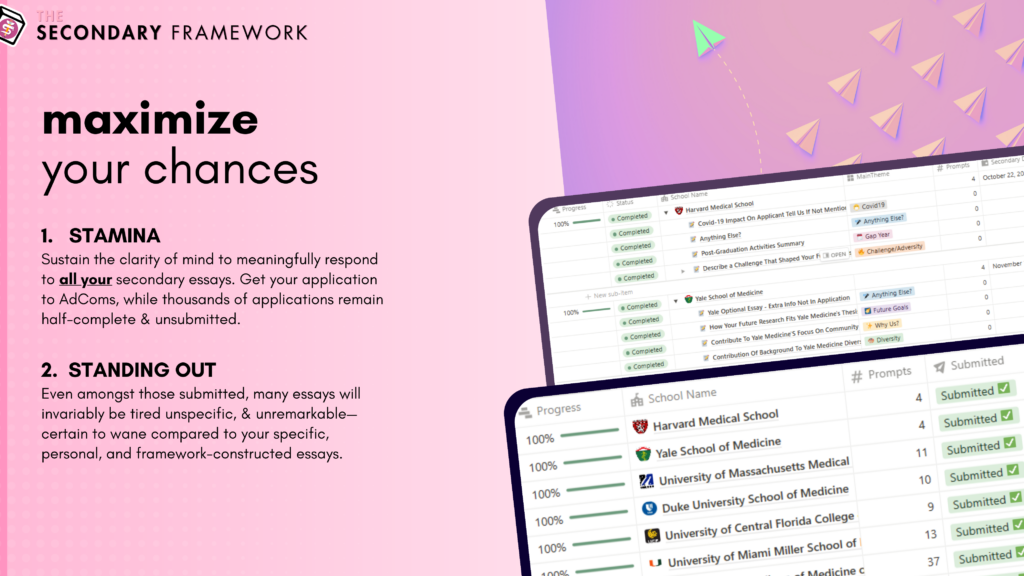Congratulations on completing the first stage of your medical school application journey! You have successfully taken the MCAT, written an impeccable personal statement, and submitted your AMCAS application to your desired schools. However, the journey is not over yet. You now face a new challenge: secondary applications.
These school-specific applications may seem like an overwhelming task, especially after the amount of effort you have invested in your primary application. But don’t worry! Secondary applications are not just another obstacle to overcome; they are a chance to demonstrate to medical schools why you are an ideal candidate for their program.
Before we explore the finer details, let us pause and understand why medical schools require secondary applications in the first place.
Secondary applications serve several key purposes. First, they allow medical schools to ask specific questions that correspond with their values and mission. While the AMCAS application provides a general overview of your credentials, secondary applications allow schools to probe deeper into the aspects they deem most important.
Secondary applications help medical schools assess your interest in their program. By devoting time to answer their questions thoroughly, you are indicating that you are genuinely interested in their school and not just applying indiscriminately; they offer an additional opportunity for you to emphasize your strengths, address any shortcomings in your application, and showcase your personal growth.
Understanding the Secondary Application
After submitting your primary application, you may think you are ready to relax. However, you must now complete the secondary application, also known as the supplemental application. This is an individual application required by each medical school you have applied to. After your primary application is verified and sent to the medical schools of your choice, these schools will then release their secondary applications.
These secondary applications can vary greatly from school to school. Some may be relatively straightforward, asking for biographical data and an additional fee. However, more often, secondary applications consist of short-answer essays that are customized to each school. These essays require significant thought, time, and the required fee.
The primary application, processed by the American Medical College Application Service (AMCAS), is a uniform application that all allopathic medical schools receive. Secondary applications are unique to each school. The primary application provides a general overview of your credentials, while the secondary application allows schools to delve deeper into aspects they deem most important.
The primary application is like a basic introduction, while the secondary application is a more thorough conversation. It is your opportunity to show each school why you are a suitable candidate for their specific program.
Secondary applications play a vital role in the admissions process. They are as important as the primary application, if not more so. Each medical school has carefully considered the questions they include on the secondary application, tailoring them to their specific needs. As such, they pay close attention to the content of these applications.
Your application is considered incomplete until you submit the secondary application, and it will not be reviewed until the secondary application is received. Therefore, it is important to return your secondaries promptly.
However, do not rush through them. The process of writing secondary applications requires you to think carefully and deeply about why you might want to attend a particular school and whether it would be a good fit for your learning style and needs. So, approach the secondaries with enthusiasm, as they are an opportunity to help the medical schools understand you more comprehensively.
Timeline For the Medical Application
Upon verification of your primary application, you can expect to begin receiving secondary applications. This is when the true challenge begins! Medical schools will start sending these out, and you might find yourself looking at a stack of applications, each with its own set of essays and questions. It can feel a bit like being hit with a tidal wave, but don’t worry, we’ve got your back.
You might be wondering, “How quickly should I be turning these secondary applications around?” Great question! The general rule of thumb is to aim to complete and submit each secondary application within one to two weeks of receiving it. This gives you enough time to thoroughly review the prompts and requirements, gather any necessary materials, and craft well-written responses.
However, keep in mind that many schools have rolling admissions and may make decisions on a rolling basis. This means the sooner you get your application in, the better. But don’t sacrifice quality for speed. It’s important to take the time to thoughtfully complete each application and tailor your responses to each school.
Also, be aware that some schools may have specific deadlines for secondary applications, so be sure to check the requirements for each school to which you have applied. If you need more time to complete a secondary application due to other commitments or unforeseen circumstances, it’s generally acceptable to request an extension. However, you should do so as soon as possible and provide a reasonable explanation for your request.
In the end, the key is to prioritize the completion of your secondary applications and to be proactive in managing your time and meeting any deadlines. This will demonstrate your commitment to the medical school admissions process and increase your chances of being accepted.
Strategies for Successful Responses
Alright, let’s dive into the nitty-gritty of crafting a killer secondary application. This is your chance to shine, to show medical schools why you’re the perfect fit for their program.
Importance of Organization and Prioritization
First things first, you need to get organized. Secondary applications can come in fast and furious, and each one is unique. Create a spreadsheet to keep track of each school, the date you received the secondary, the submission deadline, and the number of essay questions. Prioritize the schools you’re most interested in and tackle those applications first. This will help you stay on top of things and prevent you from getting overwhelmed.
Tailoring Responses to Each Medical School
Now, when it comes to writing your responses, you need to tailor them to each medical school. Do your research and find out what makes each program unique. What are their strengths? What are their values? How do these align with your own goals and values? Use this information to craft a response that shows why you’re a great fit for that specific program.
The Role of Research and Preparation in Crafting Responses
Research and preparation are key to crafting effective responses. Take the time to look at the program’s website and understand what they’re all about. This will help you answer the question: “Why is this program the right fit for me?” Be honest and genuine in your responses. If you try to embellish or stretch the truth, it will show.
The Importance of Outlining Before Writing
Before you start writing, create an outline for each essay. This will help you plan your response and prevent you from repeating ideas or themes. Remember, you want to build a cohesive narrative across your secondary application, one that enhances your primary application.
Balancing Speed and Quality in Responses
While it’s important to submit your secondary applications as quickly as possible, don’t sacrifice quality for speed. Take the time to craft well-written essays that answer the specific question being asked. Remember to weave in the themes of what makes you unique, why you’re the right fit for the program, and why you’re interested in that particular institution.
Avoiding Repetition of Primary Application Content
Avoid repeating information from your primary application. The admissions committee already has this information. Use the secondary application as an opportunity to show them something new. If you do touch on an experience that has been described before, make sure to elaborate or shine a different light on the subject.
The Risks and Benefits of Copying and Pasting Responses
While it’s okay to carry over common answers to multiple applications, be careful when doing so. Always review your response to make sure it adequately answers the question and that there’s no specific reference to another school. Tailor the response to the specific program, if possible.
The Ideal Timeframe for Completing Secondary Applications
Try to respond to secondary applications within 7-14 days of receiving them. This will keep the process moving along and give you more time to focus on your interview prep. However, don’t rush. Quality is key. Take a few days to complete secondaries, particularly the more important ones.
The Value of Getting Feedback on Secondary Applications
Finally, get feedback on your secondary essays. While it might be hard to do so due to the volume of essays, it’s important to have someone with experience in the medical school application process review your work. This can help you refine your essays and make them more effective.
Remember, secondary applications are your chance to show medical schools why you’re the perfect fit for their program. So, take the time to craft thoughtful, well-written responses that highlight your unique strengths and experiences. Good luck!
Common Pitfalls
Risks of rushing the process: The medical school secondary application process can be overwhelming, with multiple applications arriving in quick succession. It’s tempting to rush through them to get them off your plate, but this can lead to mistakes and missed opportunities to fully showcase your strengths and fit with a particular program. Prioritize quality over speed. Take the time to carefully answer each question, and don’t sacrifice the quality of your responses in the name of speed. Remember, these applications are your chance to show the admissions committee why you’re a good fit for their specific program.
Dangers of sending generic responses: Each secondary application is unique and requires a tailored response. It’s important to research each program and understand its strengths and weaknesses, and how these align with your own goals. Be specific in your responses and avoid generic answers. Show the admissions committee that you’ve taken the time to understand their program and can articulate why it’s a good fit for you.
The risk of sending the wrong school name in a response: With so many applications to complete, it’s easy to make mistakes, especially if you’re copying and pasting responses between applications. One common pitfall is accidentally sending a response with the wrong school’s name in it. This can leave a negative impression with the admissions committee and could potentially cost you an interview or acceptance. Always proofread your applications carefully before submitting them.
The importance of proofreading and editing: In addition to checking for the correct school name, it’s crucial to proofread your applications for typos, grammatical errors, and clarity. Spelling and grammar mistakes can give the impression of carelessness, which is not a quality that medical schools are looking for in their students. Consider using editing apps like Grammarly and Hemingway Editor to catch obvious errors, but don’t rely solely on these tools. Always read over your work carefully and consider asking a trusted friend or family member to review it as well.
Conclusion
The journey to medical school is arduous, and the secondary application process is a vital step along the way. It is an opportunity to showcase your unique qualities, experiences, and aspirations to the admissions committees of your chosen medical schools. The importance of secondary applications cannot be overstated; they are your chance to demonstrate your specific interest in a school and how you would add value to their program.
The process of completing secondary applications can be daunting, but remember that each application is a new opportunity to share your story and your passion for medicine. It is essential to approach each application with care, taking the time to research each school and tailor your responses to their specific prompts. Remember, the goal is not just to answer the questions but to convey your unique fit with the program and your potential to contribute to the medical community.
As you navigate the secondary application process, it is important to avoid common pitfalls such as rushing the process, sending generic responses, or making careless errors like sending the wrong school name in a response. Proofreading and editing your responses are crucial steps in ensuring that your applications are polished and professional.
Finally, remember that the application process is just that – a process. It is a journey that requires patience, resilience, and a lot of hard work. But with careful preparation and a clear focus on your goals, you can navigate this process successfully. Keep in mind that every step you take brings you closer to your dream of becoming a doctor. So, keep going, stay focused, and remember to take care of yourself along the way.







